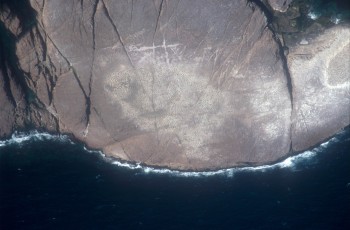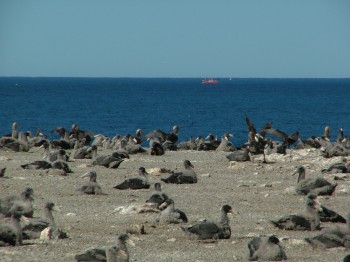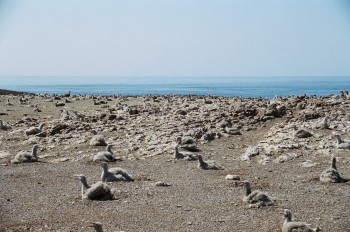Isla Gran Robredo is located in the north of the Golfo San Jorge, Patagonia, Argentina; part of the island is seen here from the air. The area contains about 70 islands and islets that are situated close to the South American Continent. Isla Gran Robredo has an area of about 18 ha. The island falls within the Parque Interjurisdiccional Marino Costero Patagonia Austral in northern Patagonia and lies 14 kilometres from the continental coast. The park was created in 2008 as an “area of conservation, management and rational use of marine and terrestrial species and their habitats” (click here).
Isla Gran Robredo is one of the few South American breeding sites of the ACAP-listed Southern Giant Petrel Macronectes giganteus. The birds breed in a rocky area free of vegetation. About 1883 breeding pairs were counted in 2004/2005. In 2012 455 chicks were counted according to the ACAP Data Portal. Earlier published counts are of 450 chicks in 1989 and 695 nests in 1992.

Part of Isla Gran Robredo from the air

Breeding in the open on Isla San Robredo

Bills open: Southern Giant Petrel chicks in the sun
Above photographs by Sofía Copello
An ongoing programme on the island’s petrels has been undertaken by Argentine researchers since 1999. During summer 2013, four solar satellite transmitters were attached to Southern Giant Petrels on nearby Isla Arce breeding colony (click here).

A satellite-tagged Southern Giant Petrel flies past. Photograph by a ranger from Punta Norte, Península Valdes, Argentina
In the 2013 a National Programme for the Conservation of the Southern Giant Petrel was approved.
Click here to access the ACAP Species Assessment for the Southern Giant Petrel. The Southern Giant Petrel is currently categorized as Least Concern and is not considered threatened.
Selected References:
Copello, S. & Quintana, F. 2009. Breeding biology of the Southern Giant Petrel (Macronectes giganteus) in Patagonia, Argentina. Revista Ornitología Neotropical 20: 369-380.
Copello, S. & Quintana, F. 2009. Spatio-temporal relationship between Southern Giant Petrels and fisheries at the Patagonian Shelf. Polar Biology 32: 1211-1220.
Copello, S., Dogliotti, A.I., Gagliardini, D.A. & Quintana, F. 2011. Oceanographic and biological landscapes used by the Southern Giant Petrel during the breeding season at the Patagonian Shelf. Marine Biology 158: 1247-1257.
Copello, S., Quintana, F. & Perez, F. 2008. The diet of the Southern Giant Petrel in Patagonia: fishery-related items and natural prey. Endangered Species Research 6: 15-23.
Patterson, D.L., Woehler, E.J., Croxall, J.P., Cooper, J., Poncet, S., Peter, H.-U., Hunter, S. & Fraser, W.R. 2008. Breeding distribution and population status of the Northern Giant Petrel Macronectes halli and Southern Giant Petrel M. giganteus. Marine Ornithology 36: 115-124.
Click here for the paper's separate appendices with historical count data.
Quintana, F., Dell' Arciprete, P. & Copello, S. 2010. Foraging behaviour and habitat use by the Southern Giant Petrel on the Patagonian Shelf. Marine Biology 157: 515-525.
Quintana, F., Punta, G., Copello, S. & Yorio, P. 2006. Population status and trends of Southern Giant Petrels (Macronectes giganteus) breeding in North Patagonia, Argentina. Polar Biology 30: 53-59.
Sofía Copello, Instituto de Investigaciones Marinas y Costeras, Consejo Nacional de Investigaciones Científicas y Técnicas (CONICET)-Universidad Nacional de Mar del Plata, Argentina, 11 December 2013

 English
English  Français
Français  Español
Español